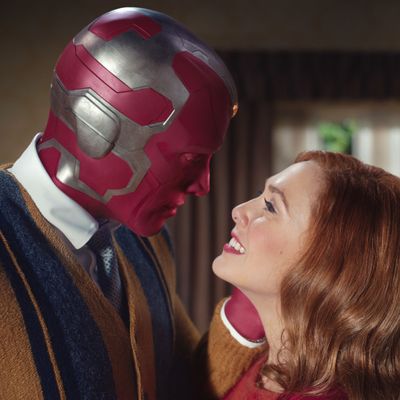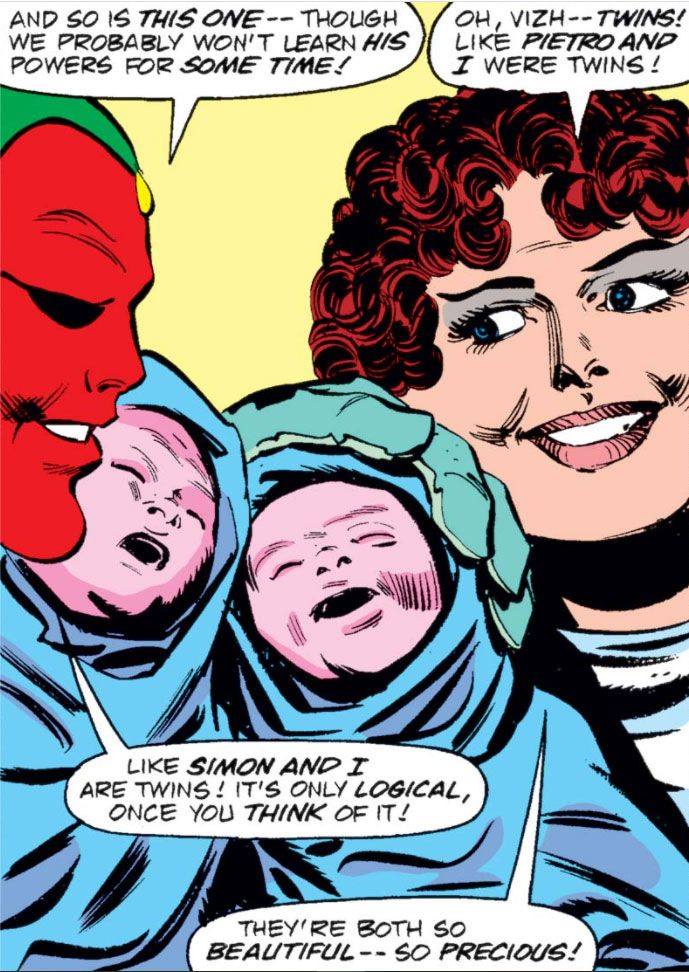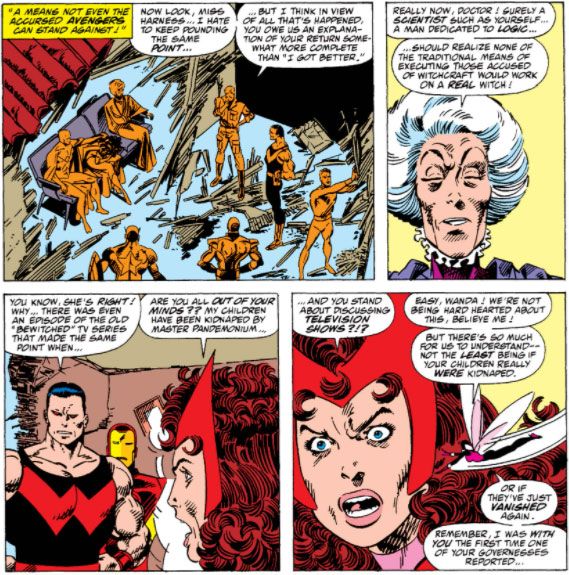
When moviegoing audiences last saw the Scarlet Witch and Vision, the latter had died as a result of Thanos plucking the last remaining Infinity Stone from his forehead near the end of 2018’s Avengers: Infinity War. Because he died before Thanos snapped his fingers (thus removing half the universe’s population), Vision was not restored to life during the events of Avengers: Endgame (2019), leaving the Scarlet Witch to mourn a more permanent loss. Why, then, do we see the pair together and happy in trailers for the Disney+ show WandaVision?
Over the course of the Marvel Cinematic Universe films, Wanda and Vision’s relationship grows organically as a consequence of the pair spending time together in crisis. Wanda was essentially under house arrest after her involvement in a public battle with former Hydra members in Nigeria that resulted in the deaths of several Wakandan visitors. To avoid another incident, Tony Stark tasked Vision with keeping Wanda out of the public eye. During that time, the two develop a connection, eventually going on the run together after Wanda becomes a fugitive for her violation of the Sokovia Accords.
This sequence of events is a far cry from the way the characters’ relationship builds up in Marvel Comics, not least because, on the page, the pair are working as teammates decades before the original Civil War event. Here, Wanda first appears as a supervillain, a member of the original lineup of the Brotherhood of Evil Mutants, under the hands of Stan Lee and Jack Kirby in 1964’s X-Men No. 4. She and her twin brother, Pietro, better known as Quicksilver, would leave the team not long after, but rather than join their fellow mutants in the X-Men for their turn to heroism, they instead become part of a new Avengers lineup under Captain America in Avengers No. 16. Both would remain members of the team until issue 53, departing once again for a brief (they appear only in three unconnected issues of other titles) career of villainy, before Wanda rejoins the Avengers without her brother in 1970’s Avengers No. 75. By that point, Vision has also become part of the team, as of Avengers No. 58. With both Wanda and Vision appearing only in Avengers, writer Roy Thomas set the pair on a romantic track, citing, in a quote given to Back Issue! magazine, a need to push the overall character development of the Avengers.
This track continued for more than a decade, leading to the pair marrying in the pages of 1975’s Giant-Size Avengers No. 4, before quitting the Avengers and pursuing a life together over the course of two series, both named Vision and the Scarlet Witch. It’s from these series that fans may be able to glean some clues about WandaVision and how it ties back to the Endgame conclusion.
The first Vision and the Scarlet Witch, begun in 1982, was a four-issue miniseries composed of loosely connected single-issue stories centered largely around the concept of familial ties. In the first issue, the couple buy a house in Leonia, New Jersey, and move in on Halloween; they’re immediately beset by an evil Druid named Samhain, who attacks them using possessed trick-or-treaters. It’s an especially interesting story to read in hindsight. While the pair wouldn’t themselves have children for another few years, the entirety of the action takes place in a domestic setting and features both characters vying against Samhain for the specific purpose of protecting children.
The issue’s Halloween setting is also of note: Remember that the trailers for WandaVision so far have featured a suburban context and a specific Halloween theme; in one scene, Vision confronts a character named Agnes (played by Katherine Hahn), who’s in an idling car, dressed in a witch’s costume. It’s a loose connection, but Vision and the Scarlet Witch No. 1 features an appearance by a minor character named Agatha Harkness, a witch and a mentor of Wanda’s.
Subsequent issues focus on Wanda’s ties to her supposed father, golden-age comics villain the Whizzer (a.k.a. Robert Frank), as well as her other supposed father, Magneto (a.k.a. Max Eisenhardt, known more popularly as Erik Lehnsherr). There are also mentions of Vision’s connections with his brothers, Wonder Man (a.k.a. Simon Williams) and Avengers villain Grim Reaper (Eric Williams), but they bear even less relevance to the ongoing story of both Wanda and Vision as featured in the MCU.
In the second volume of Vision and the Scarlet Witch, which appeared three years after the first, Wanda and Vision are once again in a domestic setting, and it’s this series in which their relationship truly becomes memorable. Not only is Wanda now with a “synthezoid,” Marvel’s proprietary designation for an android, but, as of issue three, the pair have decided to have children, which Wanda conceives through magical means in an issue that features Agatha Harkness prominently. At the end of that series, Wanda gives birth to twins, Thomas and William.
It was a landmark stunt as far as comics are concerned — it is in every way a perfectly normal domestic romance in which a committed couple decides to have children, save for the fact that one of them is an artificially created humanoid. Unfortunately, not much was done in the aftermath. The family makes a brief appearance in West Coast Avengers Annual No. 1 as a foil to Wanda’s twin brother and another in 1988’s West Coast Avengers No. 30, in which the twins’ uncle Simon reads the children a story. With the boys approaching toddlerhood by that time, Wanda and Vision join the West Coast Avengers team as of issue 35.
It’s here that writer John Byrne took over the story in 1989. As he did with Cheetah in the pages of Wonder Woman over at DC Comics, Byrne sought to return the characters to their roots, which in this case meant the four-part “Vision Quest” story line that ran in West Coast Avengers Nos. 42–45, in which Vision is disassembled and his programming is erased. He is rebuilt shortly after with his memory banks restored, but Byrne opted to eliminate a critical component: the brainwaves that had been copied over to him from Simon Williams, Wonder Man. Vision thus loses much of the character growth he accrued through the 1970s and ’80s. Instead, he is portrayed as emotionless and more disconcertingly inhuman.
In the issues following, Byrne would further alter history by retconning the now-former couple’s children, describing them as mere constructs, imaginary creations of Wanda’s mind, born of her desperate desire to have a family. Wanda’s former mentor Agatha reappears, returned from death to declare this fact and to point out that whenever Wanda isn’t directly thinking about Billy and Tommy, they simply cease to exist. As a neat bow on the events, Agatha seals off Wanda’s memories of the twins entirely, to spare her the trauma of remembering her loss. This sets the stage for the dissolution of the Avengers in 2004 in the pages of Avengers Disassembled, when writer Brian Michael Bendis took over the Avengers family of books and began a series of large-scale story events that would include the original Civil War event.
Of course, comics are infamous for their sudden reveals and breaches with continuity. Tommy and Billy would later reappear, under creators Allan Heinberg and Jim Cheung, as children of separate families. The seeds of this story were sown slowly; Billy Kaplan first appears in 2005’s Young Avengers No. 1 as a sorcerous young Asgardian (later Wiccan). Tommy, now Tommy Shepherd, appears in issue No. 10 of the same series the following year, in which the pair are immediately described as looking nearly identical by fellow teammate Stature (Cassie Lang, whom viewers may remember as Scott Lang’s daughter in the MCU films Ant-Man and Ant-Man and the Wasp). The mystery would continue until 2010’s Avengers: The Children’s Crusade, again by Heinberg and Cheung, when Wanda’s full powers and memories are restored and she confirms that Tommy and Billy are brothers and, furthermore, reincarnations of her long-lost children.
Ultimately, the trailers for WandaVision have been so vague that it’s hard to discern its arc. The MCU is certainly known for its loose adaptations of comics stories, preferring to draw on memorable character beats instead of grander plot sequences in its pursuance of largely original Marvel hero tales. For instance, the mental break and subsequent mental instability that Wanda becomes known for after the events of Avengers Disassembled, in which she reacts poorly to the sudden return of the memory of her children, are modified for use in the film Avengers: Age of Ultron, as is her history of villainy from those classic Avengers issues. Subsequent movies have shown an increase in her impact, as she’s able to manipulate Vision’s powers against his will in Captain America: Civil War before going toe-to-toe with a pair of Thanos’s lieutenants, Proxima Midnight and Corvus Glaive, in Avengers: Infinity War.
With those details established, and with the existence in the MCU of Cassie Lang/Stature in the comics, plus casting news of other Young Avengers such as America Chavez in Doctor Strange in the Multiverse of Madness (where Wanda is also due to appear), Kate Bishop in Hawkeye, and Kamala Khan in Ms. Marvel, it seems likely, though not definitive, that WandaVision will focus on the domestic stories that led to the creation of Billy and Tommy. Promo images lend support to the idea that something involving the twins certainly occurs in the new series. Could WandaVision perhaps bring us two of the most prominent Young Avengers?
Other comics scenes may provide reference points for certain Easter eggs, like the one above from 1985’s Avengers West Coast No. 51, in which Agatha and the Avengers discuss old television shows like Bewitched. What little we do know of WandaVision is that it specifically references American sitcoms of different eras, one of which is Bewitched, according to series star Elizabeth Olsen in her recent interview with Jimmy Kimmel.
As for how the series will link up with the epic conclusion of the MCU Phase 4, anything seems possible. It will be very interesting to see which elements of Vision and the Scarlet Witch’s shared past are drawn upon to explain the apparent resurrection of a dead character, one who has moved to the fore of the remaining original Avengers in the wake of Tony Stark’s death and Captain America’s retirement. Has Wanda altered reality to construct a new world where Vision is still alive? Will WandaVision take place in another corner of the multiverse where Vision never ceased living? Only time will tell.
(If you subscribe to a service through our links, Vulture may earn an affiliate commission.)



